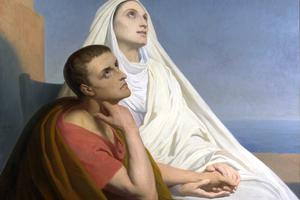Why St. Monica Is a Saint for Our Times
The life of St. Augustine offers hope; he is a real-life prodigal son.Where would the Church and the West be without him? Or, better yet, where would the Church and West be without his mother?

We all know a lapsed Catholic — sadly, some know more than one. Their absence at Mass penetrates our sorrowful hearts, inflicting a deep spiritual pain.
More than likely, they have fallen away for a variety of reasons.
Indeed, Americans who identify as Catholic dropped from 24% in 2007 to 20% in 2024; and only 20% of U.S. Catholics attend Mass weekly, pray daily, and consider religion important in their lives. Meanwhile, more than 2,000 parishes have closed in the past two decades, according to The Catholic Observer. Others, like my own in Milford and nearby New Haven, Connecticut, had to consolidate.
What hurts is that we know that “our hearts are restless till they find rest” in God, as St. Augustine wrote in Confessions. If only our loved ones recognized this truth — and that the Almighty is a merciful Father who “created man to make him share in his own blessed life.” He does not enjoy our suffering. In truth, he weeps; but he can still transform evil into good. And through Jesus Christ, we are heirs to eternal life. However, God respects our free will; and many people don’t choose him.
Others find their hearts moved back to God.
St. Augustine, one of the Church’s greatest theologians, had once apostatized, abandoning the faith as a young adult before embracing it once again after decades in the spiritual wilderness. Aside from writing some of Western civilization’s most seminal works, like City of God, he served as bishop of Hippo for nearly 35 years — from 396 to 430. His life offers hope; he is a real-life prodigal son.
Where would the Church and the West be without him? Or, better yet, where would the Church and West be without his mother, St. Monica?
Behind Augustine’s spiritual homecoming was his mother’s persistent, tireless prayer for his return to the faith. He admits as much in Confessions, writing, “In the flesh she brought me to birth in this world: in her heart she brought me to birth in [God’s] eternal light.”
For 17 years, St. Monica dutifully prayed for her son’s conversion. She succumbed to “daily tears,” as Augustine recounts, yet trusted in God’s providence after receiving a vision that she would live to see the miracle.
Before her death in 387, the same year Augustine was baptized*, St. Monica told him:
My son, for my part I find no further pleasure in this life. What I am still to do or why I am here in this world, I do not know, for I have no more to hope for on this earth. There was one reason, and one alone, why I wished to remain a little longer in this life, and that was to see you a Catholic Christian before I died. God has granted my wish and more besides, for I now see you as his servant, spurning such happiness as the world can give. What is left for me to do in this world?
Not only is she credited with leading Augustine back to the faith, but for the conversion of her pagan husband, Patricius, and his mother in 370.
St. Monica is the model for our modern times. In a world of immediacy, her patience and persevering witness should encourage all who know lapsed Catholics that God’s time is not our own — but he will, and does, answer our pleas.
The time is ripe too. Despite “nones” outpacing Protestants and Catholics for most “religious affiliation,” with 28% of Americans describing themselves as atheists, agnostics or “nothing in particular,” they have also hit a statistical ceiling.
Additionally, a new Pew Research Center study revealed that the rate of Christian apostasy has slowed and may be leveling off. Moreover, millennials and Gen Zers are increasingly identifying as Catholic, from 16% to 20% and 15% to 21% between 2022-2023, respectively. Other encouraging indicators of God’s cultural moment, as coined by Breakpoint, include the 22% rise in Bible sales and how a Rosary-themed podcast soared to No. 1.
As the Catechism of the Catholic Church explains, the “desire for God is written in the human heart” and he continually draws us closer to him. It may take a moment, a year, or decades, but God has been — and always is — working. St. Monica may have been anguished, but she did not lose faith or heart. She never failed to pray for Augustine’s conversion — and her trust was rewarded.
This is not just her story. It can be ours. Though we mourn for those fallen away, hope is not lost. Like St. Monica, we too can see our prayers answered, but we must continue praying and serving as an example of holiness — and demonstrate that the Church was christened by Jesus Christ and it has the answers to life’s questions.
By 2033, the 2,000th anniversary of Christ’s resurrection, maybe we will live to see a great return of the fallen away — like Augustine — to Mass. Until then, don’t despair if God is not working on our time: Trust in him, as St. Monica did.
* For historical reference, according to the Dictionary of Saints by John J. Delaney: “She followed him to Rome in 383 and then to Milan where, in 386, he embraced Christianity and was baptized on Easter in 387. She lived with Augustine, his son Adeodatus, and his associates at Cassiciacum while Augustine was preparing for baptism, and she died at Ostia, Italy, soon after as they were awaiting a ship to take them back to Africa.”
- Keywords:
- fallen-away catholics
- st. monica

















